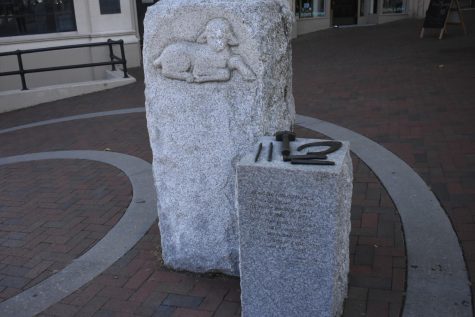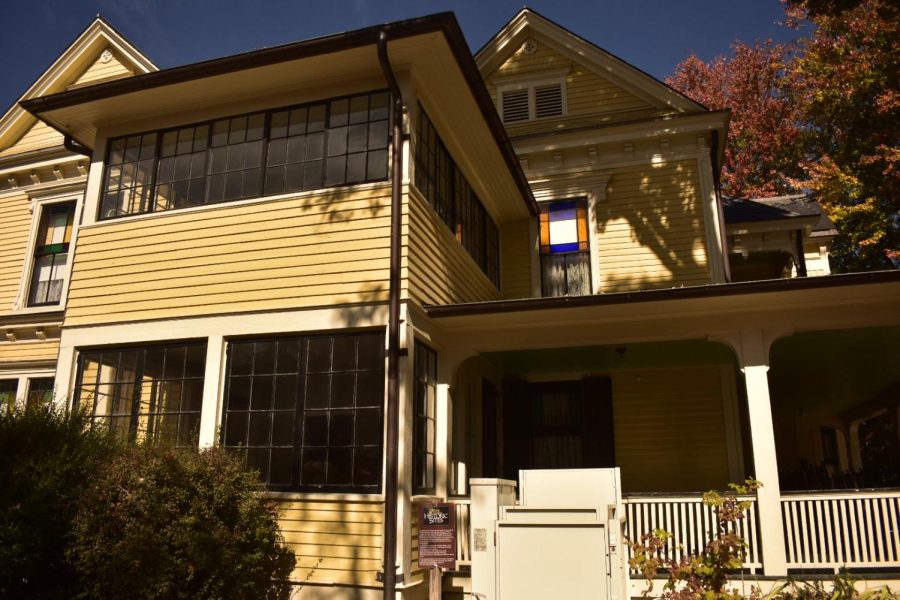Downtown Asheville’s haunted history: walking ghost tour chills onlookers
The Old Kentucky Home depicted in Thomas Wolfe’s novel, “Look Homeward Angel” is a historical site known for paranormal activity, located on 52 North Market St in downtown Asheville.
October 25, 2022
In the foggy streets of the city living amongst the Blue Ridge Mountains lies a trail of bodies. And with one quick search on trip advisor we were able to learn all about them in a span of two hours.
It’s a school night. Restaurants start to close up shop as the evening chill gradually rolls in and the stars in a cloudless sky bring dim light to downtown Asheville. Around 8 PM there are barely any cars left in the small parking lot we pull into before we make the incline to our designated meeting place, a named “alleyway behind the Asheville Masonic Temple.”
We join the crowded group gathered in front of the temple and meet our tour guide, Brian. Introductions are short and sweet and we’re quickly ushered across the street from the Thomas Wolfe museum where Brian issues a more in depth description of the tour. He talks about the book the tour is based off of and explains how the tour will take a more historical aspect on Asheville’s most haunting tales. A balance between some well-timed jokes and a story alluding to bodies under Erwin High School sets the mood and our group of about 20 are led to our first destination, The Old Kentucky Home.
Wolfe finished the novel, “Look Homeward Angel,” in that pasty yellow house, only two blocks away from where his father and seven siblings lived until their deaths throughout the early 20th century. Brian tells us a story about a conversation between Thomas and his long-dead brother Ben that lasted until dawn, something Thomas writes in this book. He mentions photographs that supposedly capture apparitions of the back of Julie’s head in the living room, lace curtains pulled back and Wolfe, appearing as if he was peeking around the corner inside the house (Brian showed us, as promised, a picture of Thomas Wolfe’s ghost upon finishing the tour).
Continuing uphill from the Thomas Wolfe museum, we’re able to sit on the concrete stairs facing Pack Square Park to catch our breath before Brian dived into his next story. In 1930, the worldwide Great Depression hit the bustling city of Asheville. Budget cuts across departments including emergency, sanitation and maintenance services were supposed to remedy the city’s debt, but it was too late. On Nov. 20, 1930, Asheville filed for bankruptcy. Just months before Mayor Gallatin Roberts was held responsible for gross mismanagement of the city bonds, he committed suicide. Where tragedy strikes spirits soon follow as Brian then tells us about One banker, going through a crisis of conscience for his role in the mayor’s schemes, jumps out of the window of his office in the Jackson building, Asheville’s first skyscraper. Supposedly the guilt of his actions still tie him, the Asheville Fire Department next door being called on three separate occasions concerning a man on the roof of the building only for him to disappear completely. There’s also been sightings of this same man approaching passerbys in the street.
As we cross over to make our way towards Eagle Street, Brian points out another strange and morbid detail. From the sidewalk where tourists and locals alike claim to meet this man, a monument placed to honor Thomas Wolfe’s father’s old stone masonry stands on the corner of the street. Just beyond it, tiles placed in the shape of a bullseye mark the floor. And while there’s no confirmation on when and why it was placed here, Asheville’s dark sense of humor seems to fill in the gaps.

We’re stopped again for a brief story, this one more legend than fact but still a staple in the ghost stories all Asheville residents like to tell. On the corner of Biltmore and Eagle street, our guide introduced us to the legend of Helen’s bridge. Pointing out into the dark, between streetlights and windy trees, we’re pointed out in the direction of Beaucatcher Mountain, home to Zealandia Castle. John Evans Brown, a politician and businessman from Lewiston, Pa., built the castle in 1889, naming it after his second wife’s home country of New Zealand.
After Brown’s death, Phillip S. Henry, described on our tour as ‘a man with a large trust fund who liked to party,’ acquired the property and renovated it to the Tudor style mansion that still stands today. During his ownership of the estate, a woman infamously known as Helen, lived and worked on the property with her child. According to Brian’s recollection of stories he’s heard, Helen wanted to attend one of Henry’s lavish parties, and allowed her daughter to play in the manor’s library. As the legend states a fire started in the kitchen and Helen’s daughter tragically passed in the accident. Devastated by the death of her child, Helen decided to end her life by hanging herself on the side of the bridge which allowed entry to and from the castle.
Yet, there are no records of a fire prior to Helen’s death and no possible way for someone to hang a makeshift noose on the bridge due its height and construction. The only record of a fire was at the horse stable in 1981, approximately 50 years after Henry’s death. The woman behind us overhears that we live in Asheville and asks if we have ever encountered any activity while at the bridge. We have not.
Continuing up the road we’re stopped beside the closed sign of Limones and the fluorescent lights of a parking garage. Brian tells us we walk the same path of a spree killer in 1906, and the danger in that statement is the most surreal experience we’ve felt all night. In the early 20th century, downtown Asheville’s commercial business flourished with the first electric streetcar downtown and expansion of railroads, accessibility to Asheville from surrounding cities became efficient. At one point, there were approximately 16-18 saloons on Biltmore Avenue.
Listening intently in the numbing cold, we heard the story of a man who went by the alias Will Harris and the massacre at Barley’s taproom. Harris, a former member of a Charlotte chain gang, hit the dirt fleeing to Asheville in search of an old lady friend, Mollie Maxwell in 1906. While in town, he bought a bottle of cheap bourbon and a .303 rifle. Eerily similar to the song Red House by Jimi Hendrix, Harris went to Maxwell’s sister, Pearl, looking for answers.
Upon hearing of her departure to Hendersonville, Harris followed Pearl Maxwell, Mollie’s sister, to her Eagle Street apartment, where multiple stories claim Harris either held her hostage or attempted to attack Maxwell. The fugitive’s behavior caught the attention of the police and he shot an officer before killing four more people on South Main Street. Harris was last seen walking south towards Patton Avenue and allegedly into Fletcher, NC. Two days after the massacre, Harris was found and police reinforcements shot the man over 100 times.
His unrecognizable body was paraded around downtown Asheville as a symbol of safety, allowing the city to run business as usual. According to the Asheville Gazette News on Nov. 17, 1906, “the dead negro may or may not be Will Harris. One thing, however, is certain, this country has been rid of one dangerous and desperate negro.” It’s uncertain if the body shot into oblivion was Will Harris but as far as the city of Asheville knew, the reign of terror was over. Brian claims even in the present, the residual screams of Ben Addison, one of Harris’ victims, can be heard.
With the crowd now fully engrossed in the experience, Brian led us to the spots with arguably the most paranormal fuel. Behind the double decker cafe and around the corner was Church Street, lined with three of Asheville’s oldest churches. In 1918, the Spanish Influenza was another epidemic that devastated Asheville’s economy. The city’s growth in population is attributed to the romanticization of the healing crisp air free of charge, however, the Spanish Flu proved otherwise. Many residents and visitors looking for alternative medicine died shortly after contracting the flu and the mortuary was flooded with decomposing bodies, running out of space for coffins. Prior to the construction of the churches, the street was used to bury remaining bodies in unmarked graves. After a century of cobblestone and concrete paving, Church Street’s foundation sits on hundreds, if not thousands, of bones. The Black Abbey is a known apparition that walks this foundation, encountering tours every now and then. As we took another rest at the front of United Methodist Church, our tour guide mentioned another incident where a light on the third floor would flicker on during the tour.
It’s near 10 PM when we make our last stop at Asheville Music Hall, right across from the destination of where our actual story takes place. A 19-year-old Helen Clevenger (no relation to Helen at the Zealandia Castle) stayed at the Battery Park Hotel while in town visiting her uncle, William Clevenger. The following morning, Clevenger reported a bloody scene of his niece’s body, badly beaten with a .32 caliber shell on the floor beside her. The Asheville Gazette reported multiple accounts of Helen’s hotel room 224 being unlocked throughout the night, giving her killer easy access. It’s unknown if Clevenger was robbed but historians and witnesses believe she was a victim of opportunity. Asheville Police spoke to bellhops, front desk clerks and hotel patrons in search of a suspect. The description of a tall, slim, bald man was given to the police, who then settled on Martin Moore, a 22-year-old bellhop who was working the night of Clevenger’s death. APD and two detectives from the NYPD successfully indicted Moore for murder after forcing his confession, later recanted, while in detention. For months and moments before his execution, Moore pleaded his innocence in hope that someone would believe him. After Moore’s swift execution, the PR nightmare was over for the city and business returned to normal. The unrestful spirits seem to remain however, as residents of the Battery Park Senior Apartments claim to not be able to stay in room 224 for more than a couple months. Meanwhile, the Asheville Pinball Museum dealt with the aggression of a ghost given a bad hand. Though we’re told with the empathy of some kind employees, not every tragic story has a tragic ending.
Our experience at the Haunted Asheville ghost tour exceeded our original expectations for it. Booking the trip with ideas of sensationalism, conspiracy theories, and romanticized legends we’ve heard before, we were surprised to leave the tour with more answers than questions. In-depth historical recollections of events in Asheville’s history motivated our curiosity to explore the gritty characters that influenced the city’s past. And we didn’t even need a jumpscare.


![Brooke Pedersen [second from the right] and Luis Reyes [right] hold banners during the Wrap The Woods event.](https://thebluebanner.net/wp-content/uploads/2025/09/ELIZABETH_PRITCHITT_IMG_3470-1200x804.jpg)
















